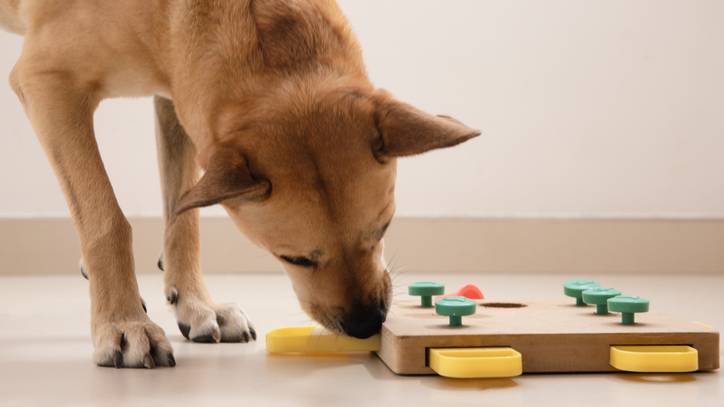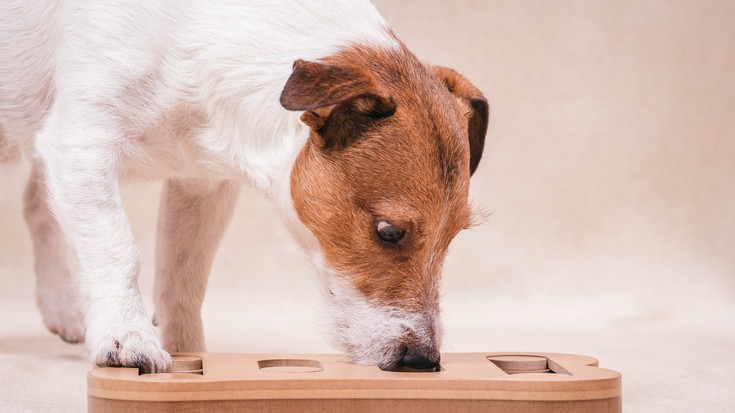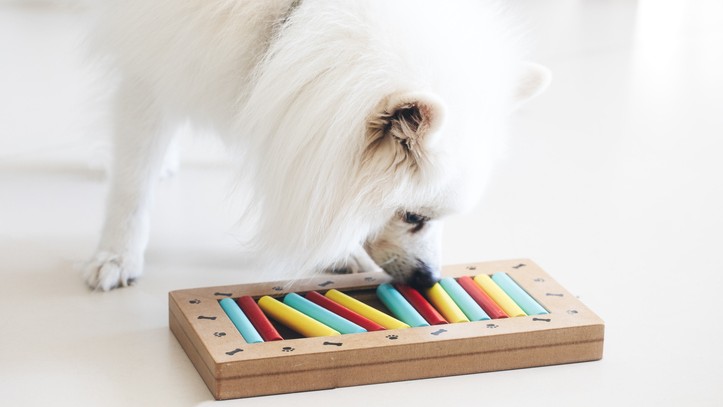9 reasons to use a dog feeding puzzle: Advice from a vet
Our resident vet gives you 9 reasons to get a dog feeding puzzle for your pooch

If you’re a pet parent to a clever canine, you might be looking for ways to make mealtimes more fun and stimulating. If this is the case, buying the best dog feeding puzzle might be the answer.
There are many different types of dog feeding puzzles on the market. Some can be used for wet dog food, others for dry dog food as well as the best dog treats. Some have moving parts, while some are mobile and need to be moved around on the floor. Even the ones that don't move at all can be great at slowing down your dog’s eating.
Food toys are great for your dog’s mental and physical health and are among the best dog toys. In fact, reward-based feeding puzzles have many excellent benefits for your canine companion. We’re going to look at the main benefits of puzzle feeders for dogs
- Best dog food: Tasty meals to keep your pooch healthy
- The best puppy treats: Reward your young dog in style
- Best dental chews for dogs: Six options to keep your dog's teeth clean
1. Keeps your dog fuller for longer
Satiety – the feeling of fullness – plays a crucial role in preventing obesity in dogs. You'll probably be familiar with that feeling of being full to burst, which suddenly descends about twenty minutes after you've squeezed in your last spoonful of dessert. Just like humans, dogs who eat their food too quickly often don’t have time to feel ‘full’. Instead, they’ll spend the next half an hour pestering their doting owners for more food, even if they don't need it – and we all know that it can be hard to say no when those big brown eyes look up at you! In fact, not being able to resist begging was the top reason pet owners gave for their dog being overweight.
Slowing down your dog's eating helps them feel full, which reduces begging and is essential for weight control. Puzzle feeders can be used with various diets (including weight-loss diets) to help your pet slow their eating and increase the feeling of fullness. So if you're wondering what to do if your dog is overweight, a puzzle feeder might help.
- Are dogs ticklish? And do they enjoy it?
- Can dogs laugh? How to know if your dog is having fun
2. Helps to prevent bloat and GDV
GDV (Gastric-dilation-volvulus) is a severe and often fatal condition where the stomach bloats and twists, blocking the blood supply to the stomach and sometimes other organs. Bloat is the less-serious version where the stomach just fills with gas without twisting.
GDV has been linked to being deep-chested, with dogs like German Shepherds, Great Danes, and standard Poodles more likely to suffer with it. It’s also been linked to certain diet types and eating too fast – aka 'scarfing' or 'gorging'.
When your dog eats like this, they swallow a lot of air, which contributes to bloating, which may result in GDV. Puzzle feeders slow your dog’s eating down, reducing the chance of your dog suffering from GDV or bloat.
3. Provides mental stimulation for your dog
Your dog is probably more intelligent than you think! After all, they evolved in forests, hunting alongside us. Some dogs have learned over 1000 words and can even infer the names of new objects. Now, when we feed our dogs from a food bowl, it requires no thought and takes no time at all. And, put simply, it gets a bit boring!
Feeding using a puzzle toy encourages your dog to use their brain and problem-solving ability to get their reward. Toys that promote these hunting and foraging instincts are great for your dog's mental ability as well as their contentment!
4. May help reduce problem behaviours
Mental stimulation can help to reduce some problem behaviors in dogs. Bored dogs are more likely to be destructive, so giving them something to work for (like a food puzzle) can entertain them and tire them out. When they are occupied or tired, they're less likely to show problem behaviors.
Behaviorists also use food toys as part of management programs for separation anxiety. In fact, food toys are so helpful they're often recommended for any problem behavior – but you should take care if your dog resource-guards and seek professional help if needed.

5. Can provide entertainment when exercise is limited
Of course, we all know the importance of exercising your dog. But as a vet, we sometimes ask that you don’t walk your dog for a few days or weeks. This is usually after surgery but may also be due to certain medical conditions or injuries.
Many owners will look at me like I’m mad when I ask them to restrict exercise for their dog – they’re often worried the dog will be ‘bouncing off the walls’ without their usual walks. A food puzzle toy can give your dog something to do that doesn't involve going out for walks. However, if exercise is severely restricted, you should pick a stationary toy rather than a ball or rolling toy.
6. Can reduce stress in your dog
Many modern dogs are exposed to stressful situations, such as loud noises, busy social situations, being left alone for periods of time, and being handled when they don’t want to be. These tiny stressful situations can add up to anxiety and even cause health problems for your dog.
Food toys can help to reduce daily stress for dogs. In fact, dog enrichment in the form of food puzzles has been shown to decrease barking, pacing, repetitive licking, and lip-smacking (a marker of stress) in shelter dogs.
- How to reduce separation anxiety in dogs: A vet's guide
7. May reduce age-related changes to the brain
Canine Cognitive Dysfunction (CCD) or 'doggy dementia' is a disease caused by degenerative brain changes in older dogs. It's very similar to Alzheimer's in humans, and symptoms such as forgetfulness, repetitive behaviors, changes in sleep-wake patterns, and anxiety are common.
The good news is that it's possible to keep the brain active well into older age using a range of brain-training games. Food puzzle toys are a great way to motivate your dog to complete various tasks and exercise their mental prowess. Some puzzles are even graded on difficulty, so you can choose a toy that suits your dog's ability.
8. Increases exercise to improve overall health
The canine obesity epidemic is just as bad as the human one. Over 50% of dogs are overweight or obese, and many have painful arthritis and joint disease as a consequence. Keeping dogs active with a puzzle feeder is an excellent way to help them burn calories while they’re eating and keep those extra pounds at bay.
If your dog is overweight but able to get around, a mobile puzzle toy, such as a treat ball or Kong Wobbler, might be a good idea. You can even increase the difficulty by putting something inside the ball to stop the kibble from falling out so quickly, thereby making your dog work harder for their dinner.
9. Helps fussy eaters
Did you know that dogs actually enjoy working for their food? In fact, many dogs show a preference for food they need to work for over food they’ve simply been offered in a bowl.
This is partly due to the endorphins released when a dog sniffs, licks, and chews – something they’ll be doing a lot of with some types of food puzzle. But the intrinsic reward of receiving something you’ve worked hard for is also an attraction for many dogs. If you have a fussy eater or one who sometimes leaves their food, puzzle toys might be one way to make them more motivated to eat.
Tips for choosing and using dog feeding puzzles

1. Choose a food puzzle that will suit your dog
You’ll need to consider their ability, mobility, interests, and food type. Terriers that like to sniff through the grass are more likely to enjoy a snuffle mat, while clever collies can handle complicated 3-step puzzles quite quickly. If your dog is fed wet food, your choices are more limited, so look closely at the materials used to make sure they’re suitable.
2. Introduce the feeding puzzle to your dog slowly
To avoid frustration, you may have to show them how to get to the food or set it to an easy setting at first. This will give them time to get used to the idea, especially if your dog has never had a food puzzle before.
3. Mix up the food you provide in the puzzle
Regular kibble is OK, but what about some cubes of carrot or a couple of treats in there too? The varying textures and smells, as well as the potential of finding something extra tasty, will keep your dog interested for longer.
4. Try to vary the puzzles day-to-day
To maintain your dog’s interest, have a couple in the cupboard and rotate them, or alternate them with DIY versions
5. Consider their daily allowance
Think of food puzzles as a way to feed your dog, not a vehicle for loads of treats. Dogs will quickly put on weight if extra food is given in food puzzles. Instead, your dog’s food puzzle should be filled with some of their daily allowance, which should be adjusted to take into account any treats they’re given to encourage them to try it.
Conclusion – Puzzle toys are a no-brainer!
Using a dog feeding puzzle has a whole range of benefits for your dog's fitness, weight, behavior, and even for their stress levels. It's a good idea to get several styles so that your dog doesn't get bored, and make sure you choose a difficulty level that's suitable for your individual pet.
PetsRadar Newsletter
Get the best advice, tips and top tech for your beloved Pets
After graduating as a vet from the University of Nottingham, Dr Joanna Woodnutt went on to practice companion animal medicine in the Midlands. Since then, she has also written for countless online and print publications and is a regular contributor for Edition Dog Magazine.

